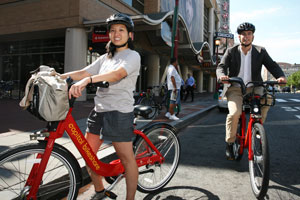In U.S. cities, the bike lane is a male-dominated zone. According to a DOT study, males outnumber females on New York City streets six to one, and nearly two to one on bike paths.
On a global scale, however, ridership is often split down the middle or skewed slightly towards females.
What accounts for the disparity in the U.S.? Over the last decade, female ridership has increased much faster than male ridership, with the former increasing by 19 percent. However, there remains a visible divide. Several advocacy groups are now discussing how to close this gap, and why it exists in the first place.
One consensus coming from these DC-centered discussions is that the lack of gender equality starts in bike shops and continues on the road. Bike shops, much like car lots, are increasingly industrial. Breaking down bikes to their individual gears and cogs makes the shops less accessible, if not intimidating, to the average person. Many shops are also entirely male-dominated spaces. “They become chains and pieces of mechanical engineering in a place of jargon and gears, one that exudes the idea of men involved in serious business,” writes John Hendel for the TBD On Foot blog.
The gender disparity continues outside the shop. According to a study detailed in this Atlantic Cities article, women feel less safe riding on the road than men do. Women are nearly twice as likely to wear helmets than are men, with 44 percent donning the lifesaving accessory. When separated bike paths are introduced, the number of women who cite safety as a reason not to ride drops significantly.
With that in mind, increased bike paths would be one way to bridge the gender divide among NYC and U.S. cyclists. Although New York has amassed a respectable system of paths, it still leaves much more to be desired when compared in an international light.
The potential for a new cycling era at large lingers over the Big Apple as New Yorkers patiently await the Citi Bike share (promised this May). Although Citi Bike’s network will at first only extend through Manhattan and Williamsburg, cyclists hope it will generate increased ridership, making roads safer, and encouraging further infrastructure development. This, in turn, can help close the existing gap.
Washington DC’s own, decidedly successful Capital Bike share has proven the effectiveness of such systems. The company’s data suggests that 51 percent of its riders are female, overall increasing their share of the road. Will Citi Bike have the same effect?
Photo: godcgo.com
